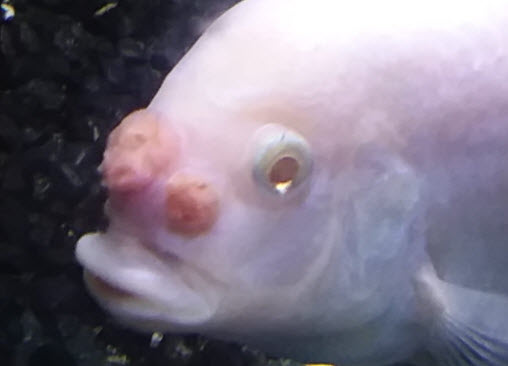
Fish commonly get a white to pink cauliflower like growth on their bodies. The disease is often referred to as “Cauliflower Disease”. It’s called Lymphocystis. Makes a wart on the fish. It is caused by a virus belonging to the Iridoviridae family. Generally, the growths are white to pink but sometimes the growth takes on the pigmentation of the skin of the fish. If a lump is smooth and round it probably isn’t lymphocystis. If it is lumpy it probably is lymphocystis.
Lymphocystis can appear quite rapidly. It is not unusual to have huge pink growths appear overnight. And the pink growths are filled with fluid. They often simply “pop” and deflate and disappear.
There is no treatment. But fish generally live quite well with the growths and the growths typically disappear in a few months. Just leaving the fish in the aquarium is generally the best course of action.
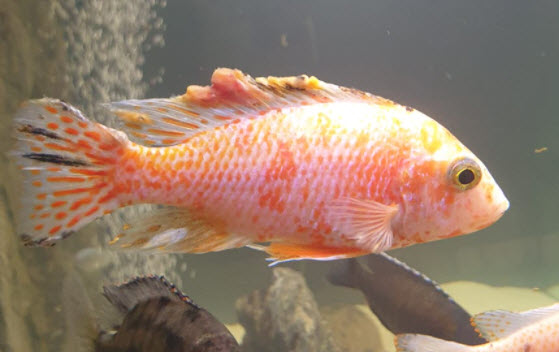
Note that a smooth growth on the skin is sometimes called a tumor or a papilloma. Tumors can be caused by many things. The point to be made is that all tumors can’t be effectively treated, just like lymphocystis, so determining the “cause” of a skin growth or tumor is not really of any importance.
With Lymphocystis the fish starts growing small white pin-prick like growths on their fins or skin and this is often mistaken for Ich/Ick (Ichthyophthirius multifiliis) in the early stages. It soon clumps together to form a cauliflower-like growth on the skin, mouth, fins, and occasionally gills. Lesions inside the mouth and nostrils and at the base of the dorsal fin are common among freshwater species of Central American origin.
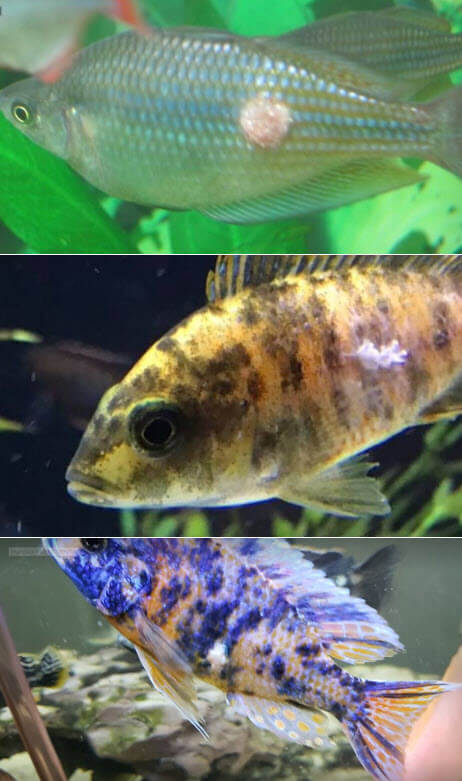
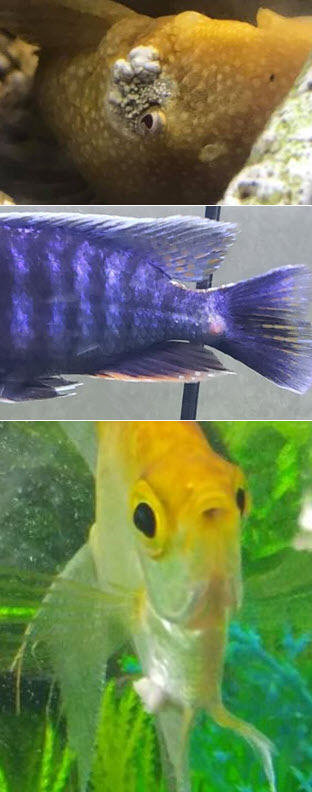
Per the reference: “Lymphocystis Disease in Fish”, R. Yanong:
“Lymphocystis is a chronic disease of freshwater and marine fishes caused by infection with an iridovirus known as Lymphocystivirus or Lymphocystis disease virus (LCDV), which is a member of the family Iridoviridae. Infection results in the development of pebble or wart-like nodules most commonly seen on the fins, skin, or gills, although other tissues may be affected. Although the disease has been seen worldwide in numerous species since its first description in 1874, its viral cause was not identified until 1962. The lymphocystiviruses are considered much less pathogenic (disease-causing) than their iridoviral relatives, the ranaviruses and megalocytiviruses, which can cause severe, systemic disease with higher mortalities.
Although lymphocystis disease normally does not cause significant mortalities, it does cause unsightly growths on fish that reduce their marketability, and in some cases, severely infected fish may die.”
Here are whole bunch of photos of fish with lymphocystis. Since I pull these photos off of social media one can get some idea that this is a very common disease.
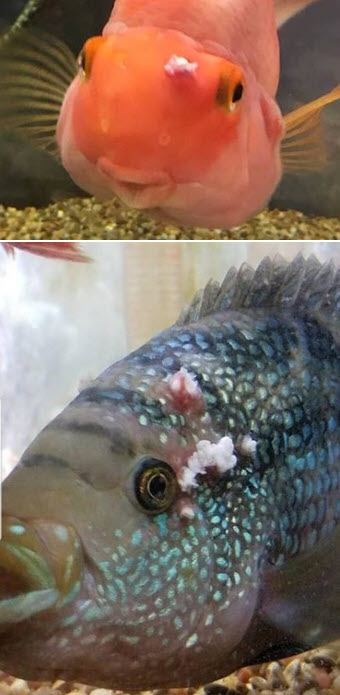
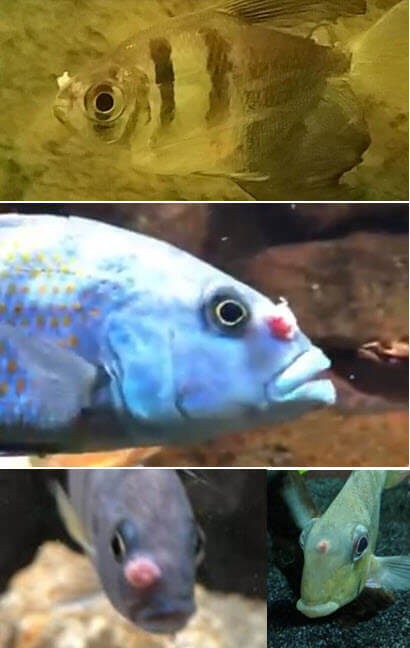
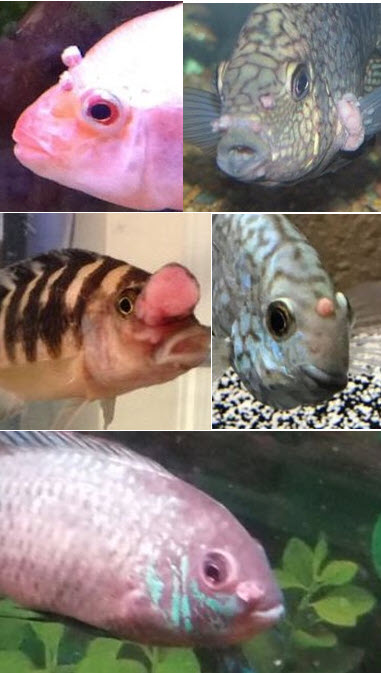

Lymphocystis does show some host-specificity, i.e., each strain (or species) of lymphocystis can infect only its primary host fish, or some additional closely related, fish. This virus appears to present itself as a lesion at differing locations and with different presentations, depending on the species of fish being attacked, often complicating diagnosis.
Treatment
As is the case with all viruses there is no medicine which is effective for lymphocystis. Over-filtration and UV water treatment can help indirectly. They lower the bacterial count in the water, which lets the fish’s immune system devout more time to the virus.
Some manufacturers (acriflavine) claim their products cure Lymphocystis. This is pure marketing hype. Viruses are all very difficult if not impossible to kill with medications. It’s like claiming you have a medication which cures the common cold. You can’t kill the virus except with very expensive and very targeted drug regimes.
If the fish is healthy and in good water typically the growths will subside with time and go away. Sometimes the growths become infected with bacteria and the fish die. It can infect other fish through cuts and abrasions. Some people cut the growths off with razor blades. But doing surgery on fish will typically kill them from shock.

Note that if you Google “treating lymphocystis” you will come up with many websites which say this and that treatment cures lymphocystis. These websites will have words that have blue letters and are underlined. These are “links”. Click on the link and you will typically find yourself at an Amazon site selling a product. Buy the product and the website and Google get a commission. How accurate do you think these websites recommendations are?
Similar Viruses
While technically members of the carp family (goldfish, koi, danios, barbs) don’t seem to get lymphocystis they do get several different skin virus “papillomas”, “warts” or “skin tumors”. Some of these viral warts are relatively slow growing and harmless while others can rapidly kill the goldfish.
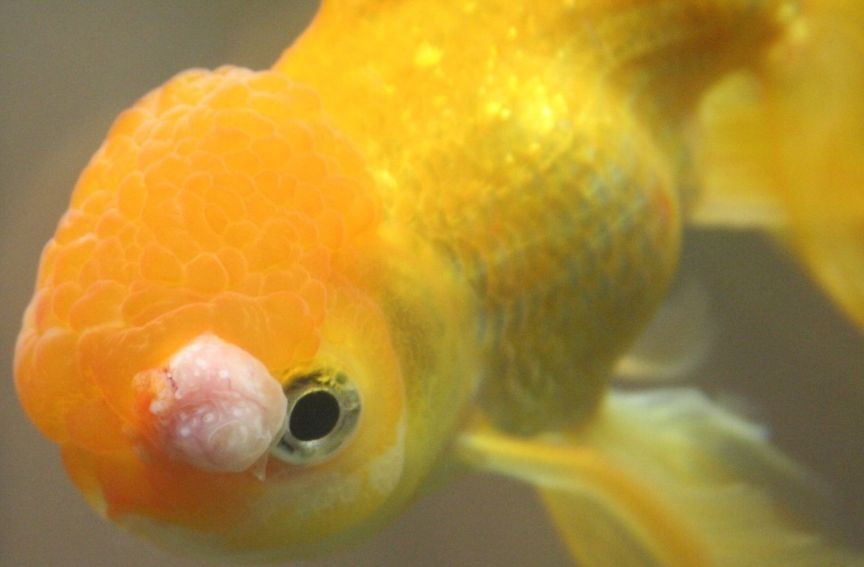
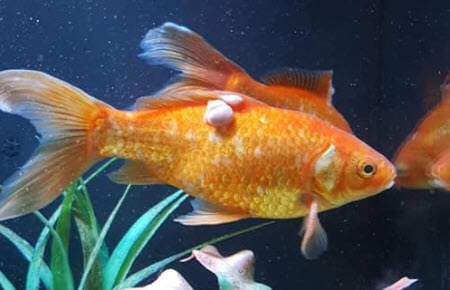
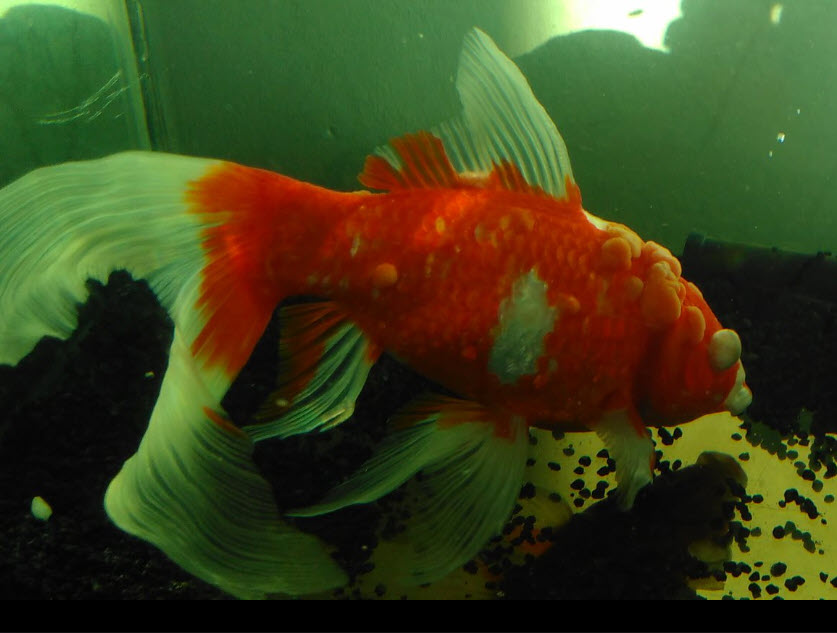
One of the goldfish skin viruses is a herpes virus called carp pox. This virus is more virulent than the lymphocystis virus and it is common for the growths to get so large that they interfere with the goldfish eating or breathing. The goldfish commonly succumb in a few years with carp pox.
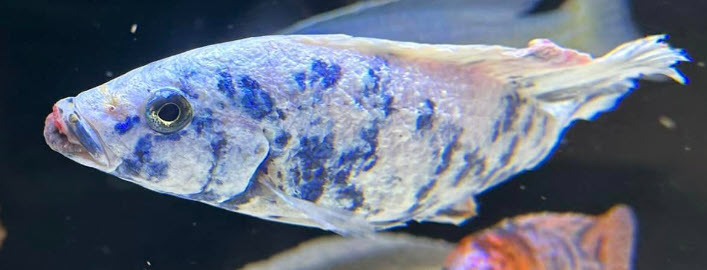
Lake Malawi Viral Growths
It appears there are certain strains of virus which infect Lake Malawi cichlids and cause a disease that look much like columnaris caused “duck lips” or lymphocystis of the mouth. But unlike columnaris this disease progresses slowly. Advanced cases have warts which appear in and on the mouth and fins. Often the entire skin surface becomes rough and deformed. The front of the anal fin seems to be a favorite location. The disease is poorly studied.
Per the person who took these photos (Kevin) research got as far as determining that the causal agent was likely some sort of retrovirus. The lesions are bony sarcomas rather than the soft, liquid-filled growths associated with lymphocystis.
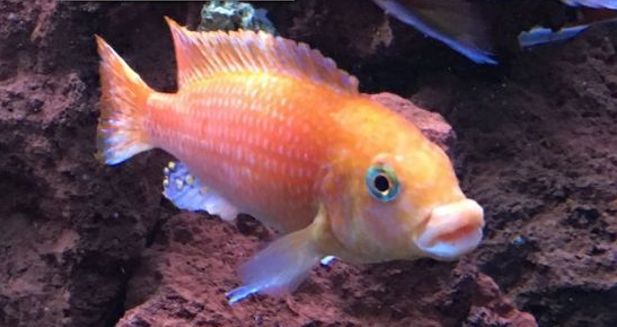
Above photo shows severe virus caused “duck lips” in a Malawi cichlid. Note there is a pink growth on the front of the anal fin (common manifestation). The photo below shows an even worse infection.
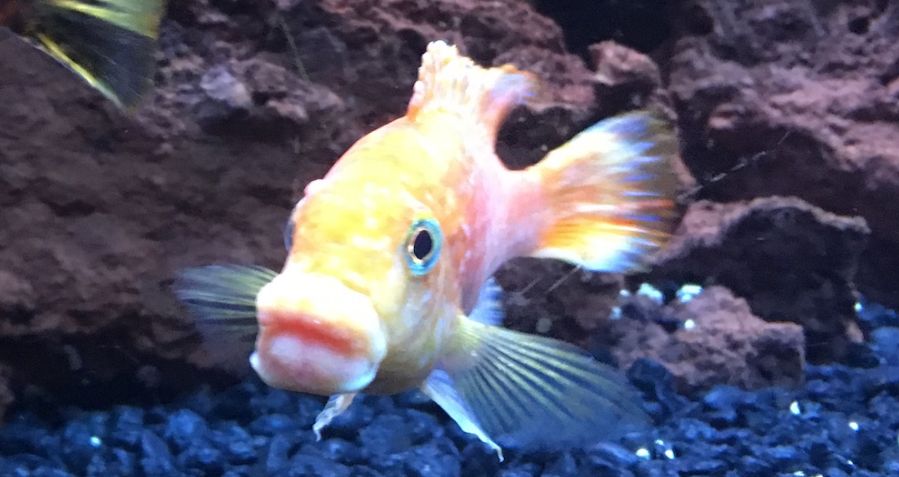
This disease seems to be much more virulent than lymphocystis. It can cause deaths. Most viruses are passed along by live fish eating the dead body of an infected fish. This virus can slowly wipe out a Malawi tank. I recommend euthanizing any Lake Malawi cichlid which gets growths on its mouth. It is hard but one does not want to lose a whole tank of fish.
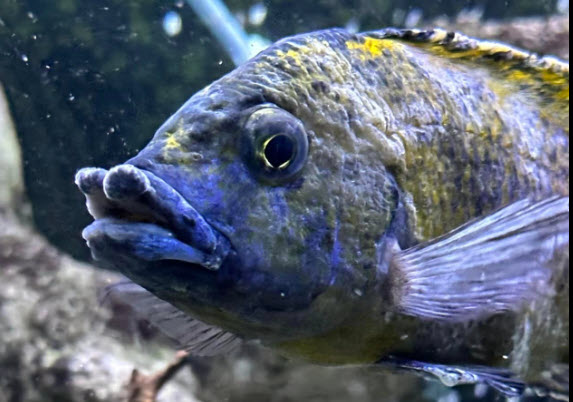
This disease often makes lumpy skin over the entire body of the fish as seen in the fish above. The fish died soon after this photo was taken.
Pleco Mouth Warts
Another disease seen only in plecos which is probably a virus related to lymphocystis is a really gnarly looking growth. I can’t find anything on it but it is probably much like lymphocystis, a growth caused by a virus.
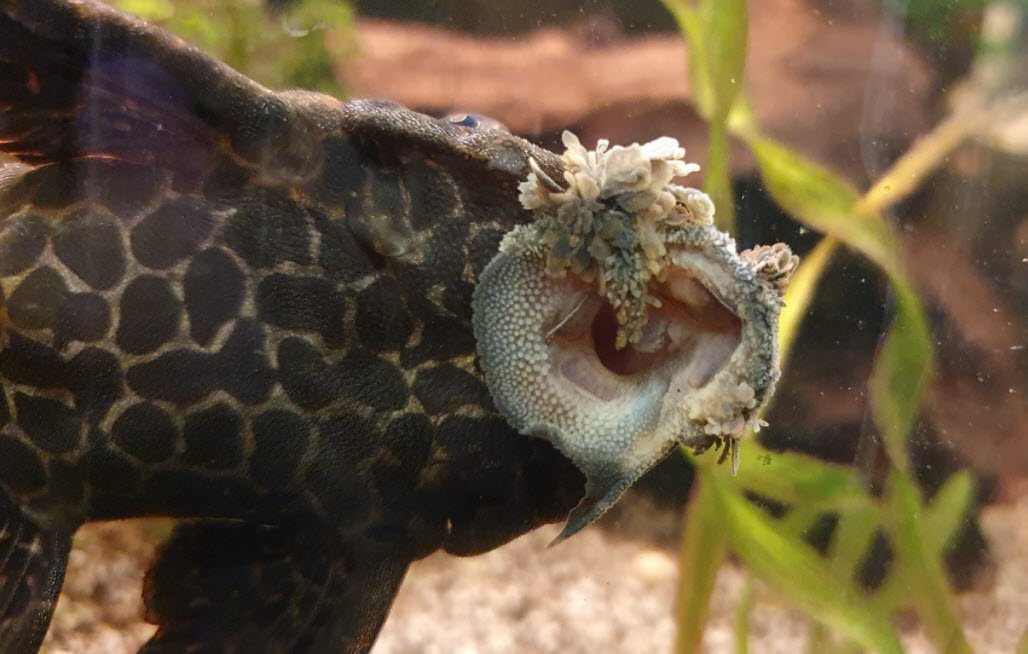
Neon Snout Chondroma
Then there is a lip wart (a “snout chondroma”) found on neon tetras which seems to be of uncertain etiology, probably caused by Neon Tetra disease.
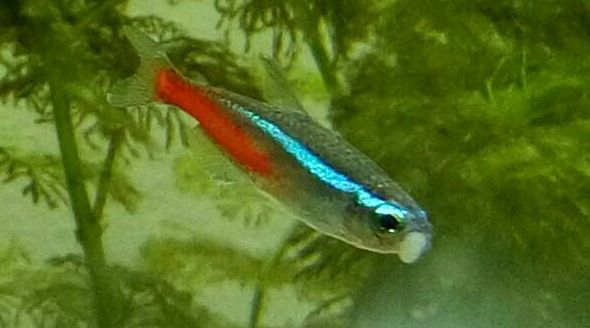
Jaw Injuries
Note there is another malady of fish commonly mistaken for Lymphocystis. This is an injury of the complex structure of a cichlid’s jaw that results in a smooth lump or bump directly above, below or in a fish’s mouth. Male cichlids commonly get these injuries from their lip locking fighting, which can get very heated.
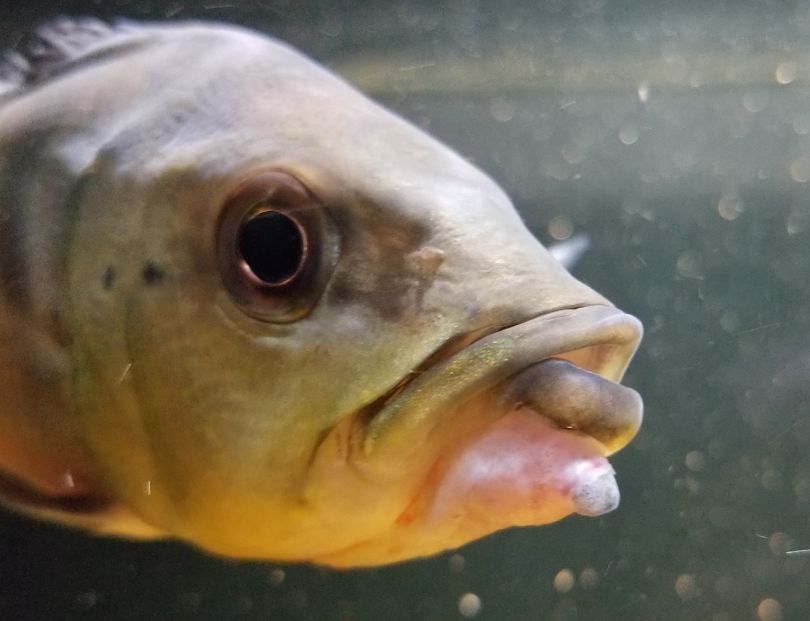
It is also very common for Oscars to get big warts on their lower lips. Most adult male Oscars have these lumps.
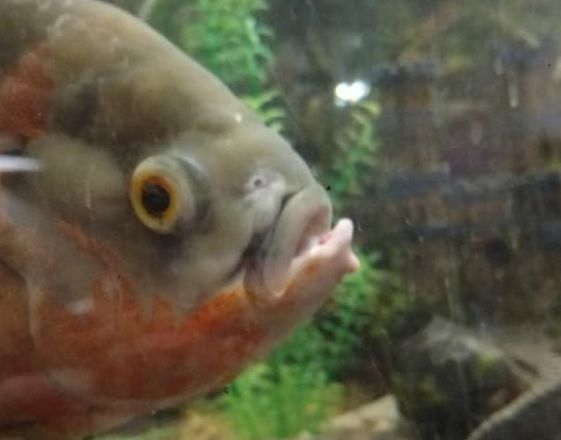
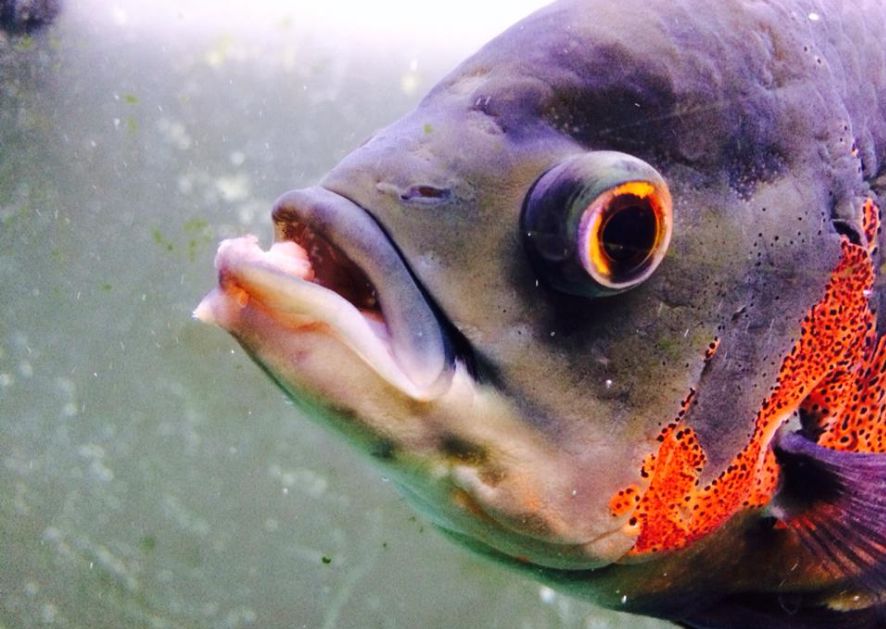
A reasonable cause for these projections is that the fish broke the skin on their jaw with fighting. The lymphocystis virus got into the skin in these injuries and causes the pink growths. But this is only a hypothesis. I can find no research on it. Some of these projections are probably lymphocystis, and some are probably simply injuries. But since there is no treatment for any of these conditions the point is moot.
Return to Diseases Menu
.
Aquarium Science Website
The chapters shown below or on the right side in maroon lead to close to 400 articles on all aspects of keeping a freshwater aquarium. These articles have NO links to profit making sites and are thus unbiased in their recommendations, unlike all the for-profit sites you will find with Google. Bookmark and browse!
.

Dave says
In reply to Alex …. No need to confirm. ANYTHING that even resembles lymphocytosis (for instance some Mycobacteriosis tubercules) will be just as resistant to treatment as lymphocystis.
Alex Perdomo says
Thank you so much for sharing all this information, I have a 5.5 inch snow-white discus which seems to have a lymphocyte growing under the eye, after reading the article and doing lots of research it seems there is nothing to do. Can you please confirm? And is there any way I can share pictures for better understanding what I am talking about?
Kristian says
Any help with pleco skin color growths on the body? Thank you.
Thanks R.buc k le r 1 1 ( ‘ ‘ ) g ma i l… c o m…. says
Get rid of the Hsv………………………………..
Sss says
My lionfish has that jaw growth like that last pic of Oscar male and it can’t eat from 2 weeks. Struggled to eat a molly and resulted in this. No idea will it make it or not but good index. My lionfish doesn’t hv that pink growth so maybe it’s injury but no use
Patrick L Hines says
Thank you for the above information, I believe my Mbuna have Lymphocystis, it started on one or 2 but is getting much worse, I have culled a few with clove oil but to get rid of it might mean culling them all, I don’t think my wife would forgive me. Very disappointing as I have cared for them very well and this is after 5 years with strong filtering.